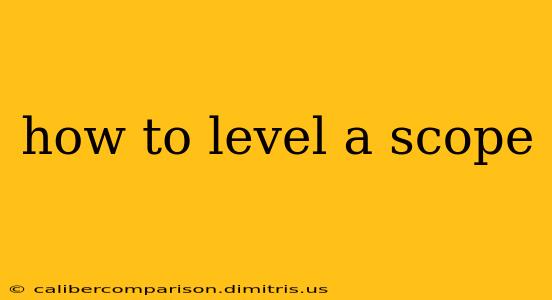Leveling your scope is crucial for accurate long-range shooting. An improperly leveled scope will lead to significant point-of-impact errors, frustrating your shooting experience and potentially compromising safety. This comprehensive guide will walk you through the process, covering various methods and troubleshooting tips.
Understanding Scope Leveling: Why It Matters
Before diving into the how-to, let's understand the why. A level scope ensures your crosshairs align perfectly with the rifle's bore, meaning the bullet will impact where your crosshairs are aimed. Without proper leveling, your shots will consistently land off-target, potentially leading to missed shots and inaccurate zeroing. This is especially important for hunting and competitive shooting, where precision is paramount.
Essential Tools for Leveling Your Scope
You'll need a few essential tools for this process:
- A bubble level: This is the most basic tool and can be a dedicated scope level or a small, versatile level. Choose one with high accuracy for best results. Digital levels offer even greater precision.
- A screwdriver: This will be needed to adjust the scope's windage and elevation turrets. Ensure you have the correct size for your scope.
- Shooting rests: A stable shooting rest or sandbags are crucial for consistent and accurate adjustments. Movement during leveling will introduce errors.
- Ammunition: You’ll need ammunition appropriate for your rifle to verify your leveling and zeroing process.
- Target: A target at an appropriate distance (consider your rifle's effective range) for zeroing and verifying your adjustments.
Method 1: Using a Scope Level
This is the most straightforward method.
- Mount the Level: Carefully attach the bubble level to your scope. Most levels are designed to magnetically attach to the scope tube, ensuring proper alignment.
- Level the Rifle: Place the rifle on a stable shooting rest or sandbags. Adjust the rifle's position until the bubble in the level is perfectly centered, indicating the scope is level horizontally.
- Adjust Windage: If the bubble isn't centered, use the appropriate screwdriver to adjust the windage turret until the bubble is perfectly centered.
- Level Vertically (Elevation): Many levels only provide horizontal leveling. For vertical leveling, you'll typically need a separate tool or use the subsequent method, involving shooting.
Method 2: Using Boresighting and Target Adjustments
This method involves shooting and adjusting based on point of impact.
- Boresighting (Optional): While not strictly necessary for leveling, boresighting can provide a good starting point. This involves using a boresighting tool to align the scope's crosshairs with the rifle's barrel. This step helps reduce the number of adjustments needed later.
- Fire a Test Shot Group: Fire a group of 3-5 shots at a known distance. Note the point of impact relative to your point of aim.
- Adjust Elevation and Windage: Based on where the shots landed, adjust the elevation and windage turrets. If the shots are consistently low, adjust the elevation turret upwards. If they consistently group to the left, adjust the windage turret to the right (and vice-versa).
- Iterate: Repeat steps 2 and 3 until your shots are consistently impacting your point of aim.
Troubleshooting Common Issues
- Inconsistent Shot Groups: This indicates issues beyond scope leveling, such as improper shooting technique, ammunition inconsistencies, or rifle problems.
- Difficulty Leveling: Ensure the level is properly mounted and the rifle is stable. A slightly uneven surface can lead to errors.
- Scope not Returning to Zero: This suggests a problem with the scope's mechanism or mounting. Consult a professional gunsmith if this happens.
Conclusion
Leveling your scope is a crucial step for accurate shooting. By carefully following these steps and using the appropriate tools, you can ensure your scope is properly aligned, leading to improved accuracy and a more enjoyable shooting experience. Remember to practice safe gun handling at all times. Always follow all relevant safety regulations and seek professional advice if you are unsure about any aspect of this process.

